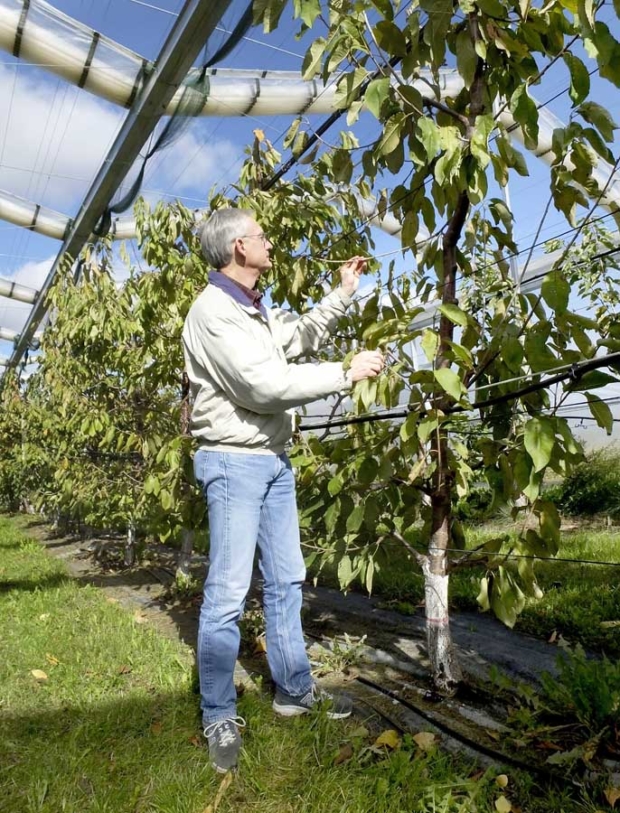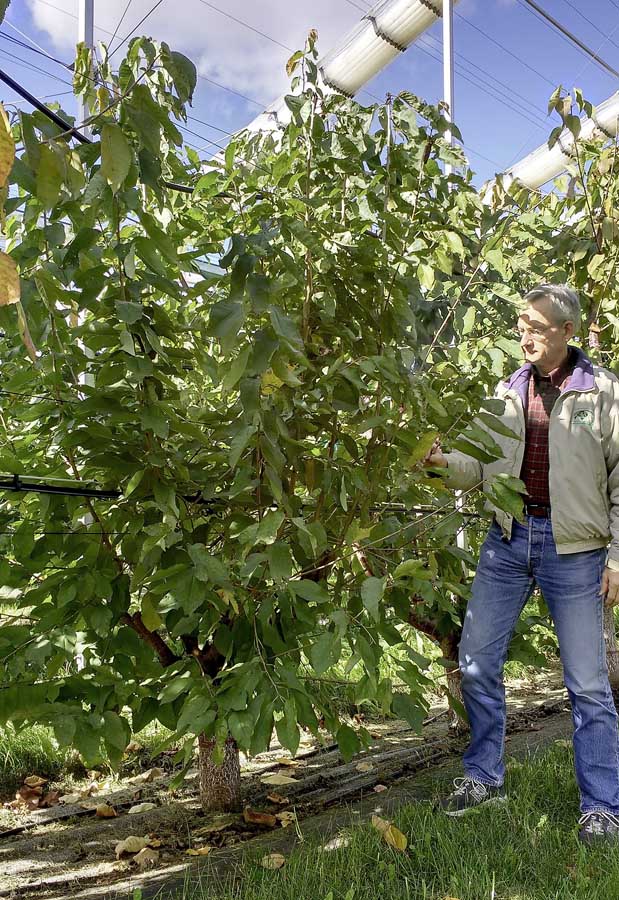
Gregory Lang of MSU examines a tree that underwent whole tree renewal before the growing season. With this approach, drastic pruning takes a tree back to the permanent wood. The idea is to provide regrowth of the same age and vigor and with excellent fruit production, while making pruning and harvesting easier. Although early in the trial, initial results are good. This tree, which combines Gisela 3 rootstock and TSA architecture, shows excellent renewal.
(by Leslie Mertz)
Whole tree renewal is an admittedly wild notion, but it appears to be working, according to Michigan State University cherry expert Gregory Lang.
Rather than renewing about one of every 10 major branches on each tree once a year, which is about standard for typical and high-density cherry orchards, he sees that proportion in a different way.
He asks, “What if we change our mindset to fully renew 10 percent of all the trees in the orchard every year so we get a very different renewal response?”
In 2015, he set out to do just that.
The idea arose when he and Matthew Whiting of Washington State University visited a cherry germplasm collection in Spain, where decades-old trees had been cut back to stumps and were vigorously re-growing.
Lang began an experiment to see what would happen if he pruned heavily bearing, dwarf “Rainier”/Gisela 3 trees with a traditional 10 percent renewal or a radical 100 percent renewal of fruiting wood.
The traditional renewal success rate was poor due to competition with the crop load, while the radical renewal success rate was 100 percent.
Consequently, in 2016 he did this with each of the combinations in his high-density trial: Gisela 3, 5 and 6 on each of four canopy architectures, including upright fruiting offshoot (UFO), Kym Green Bush (KGB), tall spindle axe (TSA) and super slender axe (SSA).
In addition, he coordinated four additional trials at agricultural research stations in New York, British Columbia and Nova Scotia. “For one of every four or eight trees, depending on the canopy architecture, we’re stubbing back the entire tree.
This is an entire removal of the crop,” he said. This radical pruning leaves about 6-inch stubs that are cut in front of one or two buds, when present, for renewal. “We know that it will be two years before these trees come back into fruiting, but we want to see how the trees develop,” he explains.
So far, whole tree renewal looks very promising on all the rootstock-architecture combinations.
“I’ve already heard from British Columbia, and they said they love it, the whole tree renewal is beautiful, and the trees look great this year. And that’s what I’m seeing too,” Lang said.

Lang is impressed with the renewal in this tree, which combines Gisela 3 rootstock and KGB architecture. It was pruned back to the permanent wood in April, but in mid-October (shown here), it has refilled the space entirely. Anecdotal reports indicate that KGB trees get back into production two years after whole tree renewal, and Lang is leading a set of trials in Michigan and elsewhere to determine whether this method offers all the advantages he envisions. (by Leslie Mertz)
Trees have shown excellent renewal with balanced, moderate new wood showing generally the same vigor. “Two years from now, the whole thing should become reproductive just like that,” he said with a snap of his fingers.
Whole tree renewal offers some obvious benefits. “First of all, we don’t have wood of all different ages that we’re going to have to manage for the next five to six years,” he says.
With same-aged wood, pruning is much easier.
“We won’t have to make the pruning decisions: Where’s the biggest one? Which should I cut? All we’ll have to do is make sure we have enough light in the tree, and then after fruiting it for five to six years, whack, we’ll do it all again.”
For example, with the UFO canopy architecture, whole tree renewal would simply require a worker to come through with a saw and cut off the tree above the cordon just above the bottom wire. “That’s all there is to it. And you’re back into production with a nice fruiting wall in three years,” he says.
Another advantage of whole tree renewal is that growers could potentially use the technique on entire rows.
“In other words, you could cut down every 10th whole row, which means you can spray that row differently from the other nine rows, because you know you won’t have fruit,” he says. “That saves costs and makes management easier.”
Lang is heartened by the results, but he acknowledges that the trial needs to run a few more years before he can endorse it to cherry growers. “The data are favorable now, but the question is what’s going to be the yield and how quickly they’ll be back into production,” he says.
In 2017, he will be carefully watching the renewal growth in his trial at MSU’s Clarksville Research Center and anxiously awaiting data from the other trial sites.
Information on crop load and fruit-to-leaf ratios will start to develop in 2018, but the key yield data will arrive in 2019. That’s when he’ll know for sure if this wild notion may indeed be as good an idea as he hopes it is.
“It looks really encouraging, but the next couple of years will tell,” he said. •
– by Leslie Mertz, Ph.D., a freelance writer based in Gaylord, Michigan.






Leave A Comment